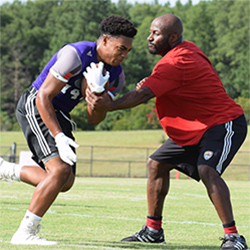The winter and spring months are the most important for any young football player. You win in the fall with work in the spring, and when you’re in the midst of an ‘offseason’ there’s ample time and opportunity to elevate your game and own your position before practice begins in August.
As an athlete born and raised in Connecticut, the available opportunities to develop every offseason – and those dedicated enough to provide them – were slim. I distinctly recall receiving an invite to a camp in seventh grade, where the autograph and photo session of the coaches in attendance was longer than the cumulative amount spent on the field. Like many young athletes, no matter their location, I wanted my future to start immediately and I wanted it to include college athletics. I wasn’t interested in an autograph, I just wanted to play football. And as often as possible.
Football is a sport that requires lots of multi-limb co-ordinations each second of every play. The top players at any level are those that can perform these movements with speed, precision and control. Technical ability, coupled with football IQ, is the clearest differentiator between top level players and average players at every level of football. Technique plus talent beats talent alone is the truth of football. In every competitive practice rep and every one-on-one matchup in a game, a player will emerge victorious over another because of his technical supremacy.
An overwhelming majority of athletes realize that truth and the weight of its importance too late in their lives. For some, they fully comprehend it when they are already entrenched in a high school career. By that point muscle memorization encompasses routines that rely on talent alone. For most high school football players, by the time they reach the conclusions of their sophomore seasons they only have two years of football left in their lives. At that age, all the hours that should have been spent working on technical aspects of the game are long gone, never to be recovered.
Developing technique starts with a deliberate focus on practice and repetition. Footwork, hand usage, throwing, stance, catching, etc. — these are not abilities that can be dissected and thought about mid-game. These by-position techniques must be fundamentally ingrained into the player. Technique is a habit.

Its habitual nature and the dividends it pays can be seen not just in football but in all sports. Giants of European soccer have youth academies that start as young as seven years old, and a primary focus is technique. At that age of seven, technique is established as the most important differentiator. Some academies are shaped with a T.I.P.S. model – Technique, Insight (awareness and IQ), Personality, and Speed. The latter two are innate properties, but a player’s Technique and Insight can always be developed further. That notion is communicated from day one – the chase for technical perfection is constant.
Improvement occurs with correctly and consistently implemented fundamentals. Advanced players — the ones that jump off the screen in highlight tapes — understand the value of supplemental training with coaches leading and directing every step of the way. but most if not all of them will have accumulated thousands of extra reps before they begin their varsity careers. They separate themselves from the pack on their own. Coaches know those players put themselves ahead of the curve. When attending a showcase or college camp as underclassmen, those with advanced technique stand out from the pack. A head coach, or even a graduate assistant for that matter, knows those players will arrive on their college campus as a freshman with a full toolbox — as opposed to one hammer and a couple nails.
In Malcolm Gladwell’s Outliers, the theme of a “10,000-Hour Rule” appears throughout. Gladwell claims that greatness requires enormous time; it takes 10,000 hours to become an ‘expert’ in any field or profession. This theme can be flexed to a degree of repetitions in sport. In soccer, coaches in youth academies make their under-9 players go through 10,000 touches on the ball each day at training sessions – and on off days, it is understood by the players that they must go through the routine of 10,000 touches individually. Steph Curry takes a minimum of 2,000 shots every week, not counting games.
The in-season portion of Tom Brady’s daily regimen is designed to run through Super Bowl Sunday; if New England’s campaign ends in a playoff loss, Brady completes every drill, every throw, anyway.
Every repetition on the field is like dropping money into a piggybank — a tangible investment that adds up substantially over time. Start refining the fundamentals and techniques of your position at a young age, and your football development will be more advanced by the time you’re competing for varsity snaps.
By Mike Ulatoski @themikeulatoski
Your point of view caught my eye and was very interesting. Thanks. I have a question for you. https://www.binance.com/es/register?ref=PORL8W0Z
Your point of view caught my eye and was very interesting. Thanks. I have a question for you. https://accounts.binance.com/ph/register?ref=DB40ITMB
I may need your help. I tried many ways but couldn’t solve it, but after reading your article, I think you have a way to help me. I’m looking forward for your reply. Thanks.